Agave plants with their iconic leaves and striking appearance, bring a dramatic presence and add a bold, geometrical nuance to landscape architecture. Agaves are well suited for the extremely arid conditions of the desert, with tough, spiny exteriors that protect their highly sought-after moisture from natural predators. Although agaves share intrinsic traits common to all succulents, such as dense fleshiness and swollen leaves, several other characteristics set them apart from other plants in their classification.
All 270 recognized species of the agave are identified by the leathery leaves that swirl around a central core in a rosette formation. The leaves grow from a minimum of 6 to up to 20 inches in length, and the edges are rimmed with teeth. They mature in eight to 10 years and then only once; the bloom saps the plant of its energy before dying. The mature plant drops “pups” that are its way of propagating itself. They are drought resistant and need little maintenance.
Characteristics of Agave Plants
Leaves
Agave leaves are succulent or semi-succulent and are short and broad in some species while long and narrow in others. The fleshy agave leaves, which vary in color from green to bluish- or grayish-green and sometimes striped or mottled, are arranged in rosettes that can measure from only a few inches wide to more than 12 feet across and tall. Agave leaf margins usually have sharp spines and each leaf tip generally has a sharp stiff spine, although a few agave species lack spines.
Flower Stalk and Flowers
As an agave plant ages, it accumulates, over many years, a large amount of sugar and starch in the heart tissue at the center of the rosette of leaves, fueling the growth of a tall, branched or unbranched flower stalk, usually after at least 10 to 30 years of vegetative growth. The rapidly developing stalk can rise 6 to 40 feet above the rosette and the short, tubular flowers at the top of the stalk are white, yellow or rose-colored.
Pups and Bulbils
While nearly all agaves die shortly after flowering, most produce vegetative offshoots known as pups, or suckers, before or after flowering. Each pup, which emerges from near the base of the parent plant, has a rosette of leaves itself. These pups can form colonies, if left intact, or you can dig them up and sever them from the parent agave and plant them elsewhere. Some species of agave produce bulbils, or plantlets, on the flowering stalk.
Root System
The agave’s root system is shallow and does not extend far beyond the above-ground portion of the plant, but it is extensive and dense. The agave root system is designed to help the agave efficiently capture moisture from rain, condensation and dew. Most agaves also produce underground suckers that allow the plant to multiply and form colonies, which can become quite large. Excellent drainage around agave roots is extremely important.
List of Types of Agave Plants
- Spider agave (Agave bracteosa)
- Blue agave (Agave tequilana)
- Agave americana (Century Plant)
- White hair agave (Agave albopilosa)
- Agave angustifolia (Caribbean agave)
- Agave ‘Kissho Kan’ (Butterfly Agave)
- Agave colorata (Mescal Ceniza)
- Queen Victoria agave (Agave victoriae-reginae)
- Twin-flowered agave (Agave geminflora)
- Agave filifera (Thread Agave)
- Agave franzosinii (Majestic Agave)
- Agave havardiana (Havard Agave)
- Foxtail agave (Agave attenuata)
- Agave macroacantha (Black-Spined Agave)
- Agave montana (Mountain Agave)
- Agave marmorata (Marbled Agave)
- Agave nickelsiae (King of the Agaves)
- Agave ovatifolia ‘Frosty Blue’ (Whale’s Tongue Agave)
- Agave ovatifolia (Whale’s Tongue Agave)
- Agave parrasana (Cabbage Head Agave)
- Agave parryi (Artichoke Agave)
- Agave shawii (Coastal Agave)
- Agave striata (Narrow Leaf Century Plant)
- Agave utahensis (Utah Agave)
- Agave vilmoriniana (Octopus Agave)
- Agave weberi ‘Arizona Star’ (Weber Agave)
- Agave univittata ‘Quadricolor’
- Agave asperrima (Agave Scabra)
- Agave bovicornuta (Cow Horn Agave)
- Agave guiengola (Agave Creme Brulee)
Spider agave
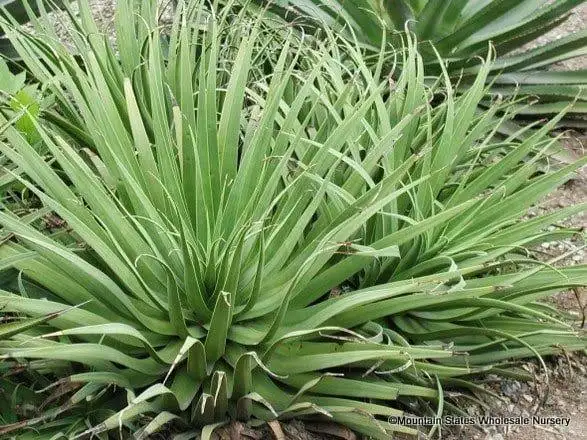
Native to rocky cliffs of central Mexico, spider agave (Agave bracteosa) have arching, flexible, slender leaves growing from a central point, making them resemble many-legged spiders perched on the rocks. Medium-green leaves are about 2 feet long. Spider agave produces spike-like flower stalks bearing copious yellow blooms and is one of the few agave varieties that does not die after blooming.
Also Read: Different Types of Echeveria Plants
Blue agave

The long blue-gray leaves have sharp teeth along the edges and a terminal spine that is hard and sharp enough to pierce through bone. You should dig up and transplant a blue agave if it grows to interfere with foot traffic where the plants could cause injury, especially to children and pets. The impressive blue agave may reach a height of 6 to 8 feet and grow just as wide. The mature blue agave shoots an edible flower stalk over 15 feet tall, which signals the approach of life’s end.
Agave americana

The Agave americana also goes by the common names of American aloe or century plant. The foliage of the Century plant consists of rosettes that are rigid but rather fleshy along with leaves that have spiny edges. It is gray-green in color. The flowers of the Agave americana is green-yellow in color and can grow up to 8cm in length in clusters. These flowers grow on a large stem that reaches heights much taller than the actual plant.
White hair agave
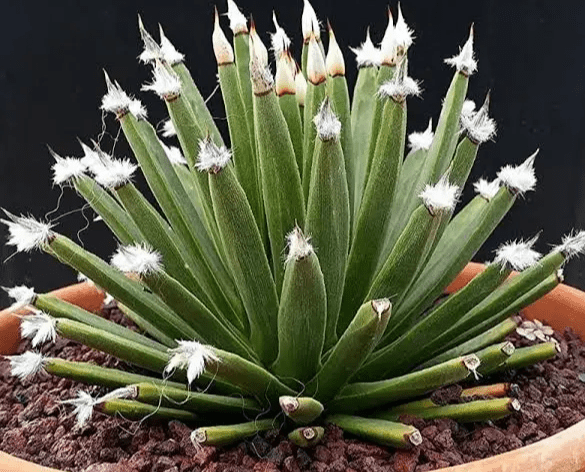
The white hair agave is an extra small species forming solitary or clustered balls of numerous, narrow leaves. It is unique in the genus and distinguished by the very peculiar full ring of white hairlike fibers just underneath the terminal spine.
From a distance, it looks like cotton balls on the end of each leaf, however, the new leaves do not carry hair, but the thorny area around the terminal spine looks a bit like the tip of a triangular wooden pencil that opens like a mesemb capsule to reveal the snow-white fibers. It is very slow-growing and will grow to around 30 cm in diameter.
Agave angustifolia

Agave angustifolia is grown for its striking shape and ability to withstand periods of little or no water. It is very popular in small courtyards and outdoor pots. The thick leaves have serrated edges in a rosette formation. It may take 10 years to flower but when it does the flower is quite spectacular. The flower inflorescence appears at the end of tall stalk (up to 2.5m). The plant develops suckers from the base and bulbils from along the stalk that fall off and and grow into new plants.
Also Read: Major Varieties of Succulents For Your Home Garden
Agave ‘Kissho Kan’
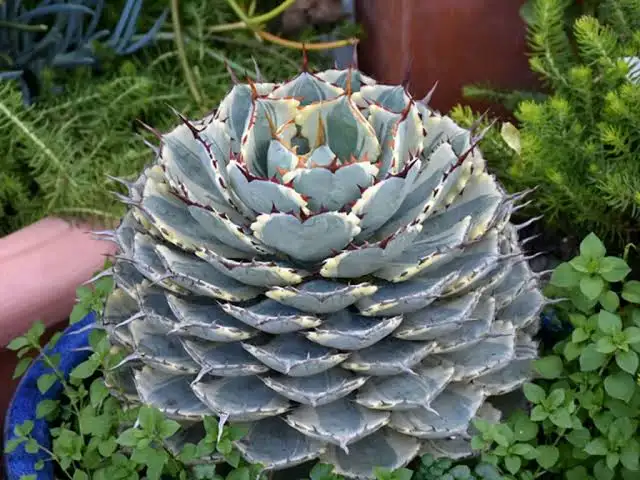
Agave ‘Kissho Kan’ perfectly forms a symmetrical rosette of thick, rigid, soft silver-blue to blue-green leaves. The foliage is adorned with creamy white toothed margins and leaf spines, which emerge yellow, change to pale brown before turning dark reddish-brown. Quite compact, ‘Kissho Kan’ is a terrific addition to pots or containers. Mature plants produce offshoots that can be rooted and propagated easily.
Twin-flowered agave
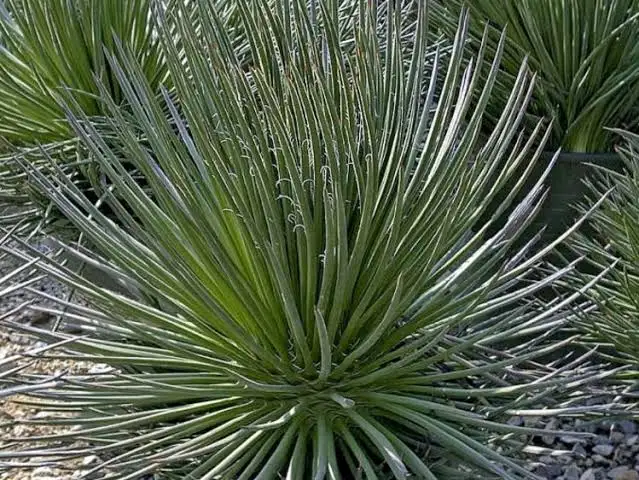
The growth form of twin-flowered agave (Agave geminflora) is distinct within the genus. Very slender spineless leaves make an airy, domed basal rosette that has a delicate appearance, although this is a drought- and heat-tolerant plant. Also suited for containers as well as gardens, this is a slow-growing species. It tends to be solitary, with a few offsets produced in old age. Paired yellow flowers appear along an 8- to 10-foot-tall flower stalk.
This striking Agave holds up well in drought situations and can take light freezes. It is wonderful when used as a specimen or simply to provide year-round foliage color. It is often used in a pot as a patio plant where it makes an eye-catching statement.
Agave colorata

The Mescal Ceniza (Agave colorata) is an attractive wide-leafed agave with succulent rosettes 60 to 120 cm in diameter with jagged spines on the leaf margins. This plant is usually solitary and does not often send up many plants around the main rosette, but sometimes It may slowly clump and mature plants develop a short stem.
This rosette-forming succulent agave is a slowly growing ,rosette-forming plant that matures and blooms (around 15 years) in spring with red buds opening to yellow and orange flowers in a panicle on a 3 m tall stalk.
Queen Victoria agave
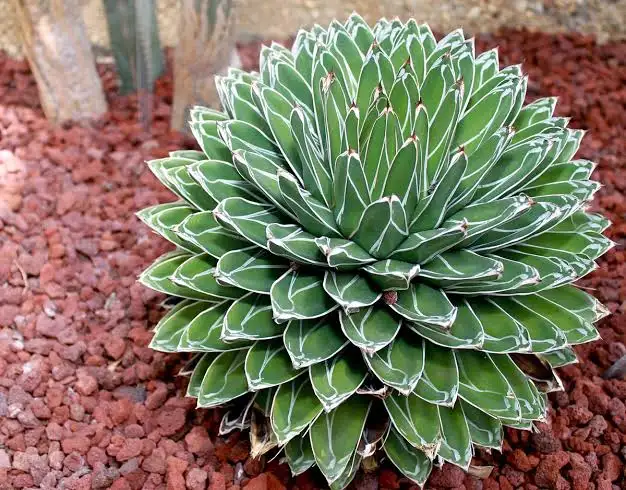
Dark green leaves of Queen Victoria agave, also called royal agave (Agave victoriae-reginae), are elegantly pencilled with pure white. Spineless leaves are edged in reddish-brown. Although leaves of the species agave are tipped with a dark spine, the cultivar “Compacta” possesses smaller, blunter terminal spines.
This agave does not form offsets and must be grown from seed. A fairly small compact agave, it is 18 to 24 inches tall and wide, making it suitable for container growing. It is slow-growing and long-lived, producing a spike-like 13- to 15-foot-tall flower stalk when mature, after which it dies.
Thread-edge Agave
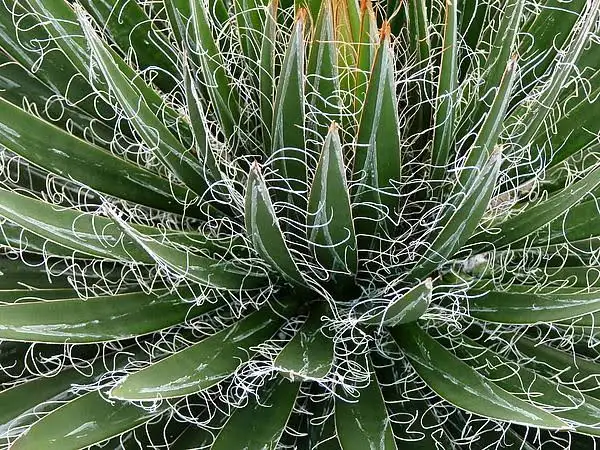
Thread-edge agave is a beautiful compact clustering plant to 3 feet wide with few offsets, each rosette growing to about a foot tall by 15 to 24 inches wide by each 6 inch to 1 foot wide. The leaves are mid-green leaves, broadest toward their middle and with striking white filaments along the margins, white bud markings on the leaf surfaces and sharp grayish terminal spined that are flat on top and rounded below.
This plants are most attractive when water stressed in full sun as the leaves will often have shades of red. The non-branching flower spikes are 6 to 8 feet tall with reddish-green flowers. It makes a dramatic focal point in the landscape.
Majestic agave
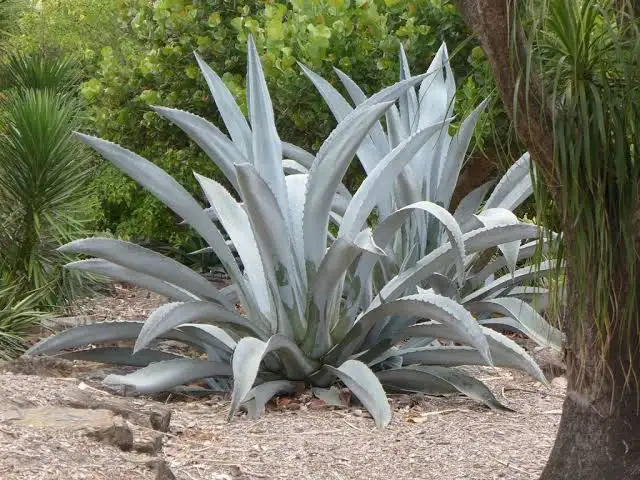
Agave franzosinii is a very large, evergreen perennial forming a usually solitary rosette of thick, spiny-edged, powdery blue-gray leaves that arch gracefully. While many agaves are coated with a waxy glaucus that helps reflect sunlight and conserve water, this agave displays interesting dark green patterns where the wax has been rubbed off as the leaves grow.
The leaves are lined with large teeth along their margins and feature a dark brown terminal spine. While infrequent, mature plants (at least 12 years old) are topped with a magnificent flower stalk that bears large bright yellow flowers. A slow grower, this majestic Agave dies after flowering but forms rhizomes that generally produce new shoots a few feet feet from the main rosette.
Also Read: Different Types of Yellow Succulents For Your Home Garden
Havard agave

Agave havardiana (Havard agave) is an attractive midsized Agave to 2 to 3 feet tall by 3 to 4 feet wide with a tight rosette bearing stout short broad silver-gray to nearly white leaves with dark brown mariginal and terminal spines. It is usually solitary but occasionally older plants can produce offsets. When mature the plant flowers in summer to fall with yellow-green flowers held on a tall branched spike.
Foxtail agave
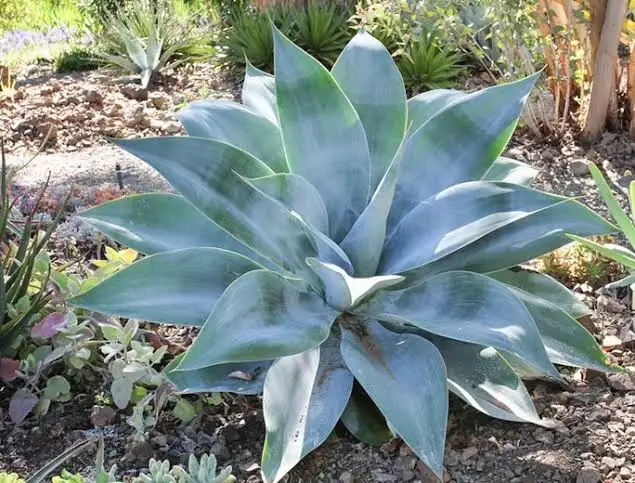
Leaves of foxtail agave, also called spineless century plant (Agave attenuata), have broad, tapering 18- to 28-inch-long light green or blue-green leaves. Basal rosettes are 2 to 3 feet high and 3 to 4 feet wide. They are used as specimen or accent plants and also in mass plantings. After about 10 to 15 years, foxtail agave produces a 5- to 10-foot-tall flower stalk that curves and droops at the terminal end. Many yellow-green flowers make the arched fuzzy-looking flower stalk resemble a furry tail, hence the common name foxtail agave.
Black-spined Agave
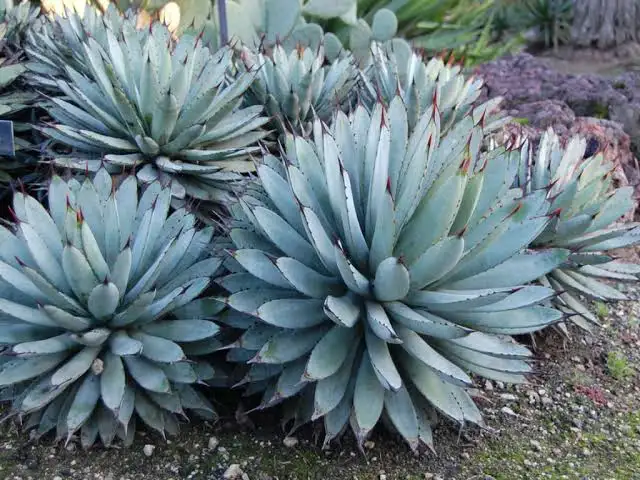
Black-spined Agave is a medium sized agave that forms dense clumps to 60 cm tall by 1.5 m wide composed of very regular leaf rosettes of a bluish grey colour that can be basal or can grow on a very short stem. Leaves are succulent, narrow sword-shaped blue-grey or greyish green and up to 35 cm long at a maximum, ending in sharp, contrasting, black spines at the tips.
Flowers are small, purple-tinged green with a fuzzy interior, growing in bunches on sturdy stems of up to 3 m in height. In the wild it is a very variable plant, with some populations having large, jet-black terminal spines, some having red-brown spines, some with small spines, some large.
Mountain Agave
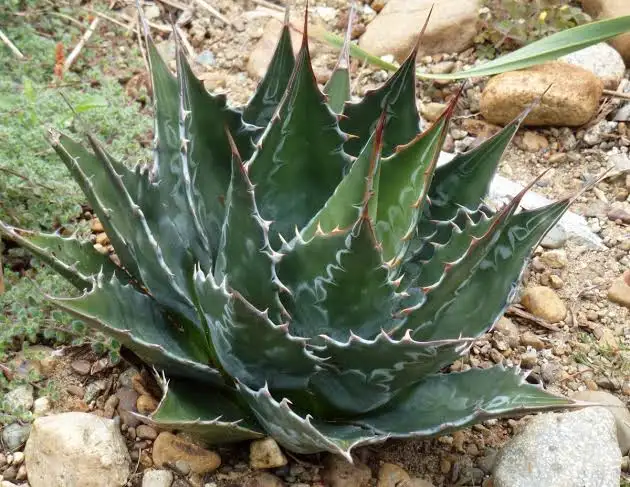
Agave montana, the Mountain Agave, is a particularly handsome Agave that stay solitary (doesn’t offset). It forms a very symmetrical artichoke-like rosette of dark green leaves usually covered with a pale frosting of whitish bloom and carrying on their lower surfaces the distinct impressions of the thorny leaf margins of the previous outer leaf-bud. These thorns and the strong terminal thorn are a contrasting reddish brown.
Like many in its family plant dies after blooming but does not sucker or form offsets so when it gets killed its gone, however the seeds do germinate very easily. As with most agaves, individual clones vary considerably.
Marbled Agave
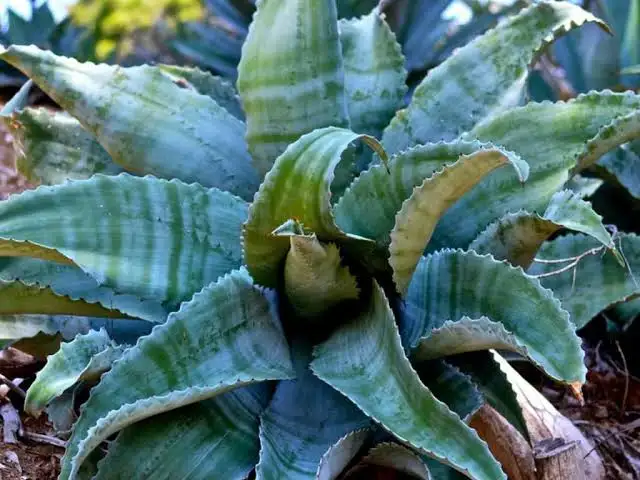
Agave marmorata (Marbled Agave) is a medium-sized evergreen succulent forming a handsome solitary rosette with up to 30-50 large, broad, blue-gray, convoluted leaves, often adorned with pale blue and gray-green stripes. The colorful banding is highlighted as the leaves unfurl from around the central cone.
The leaves are deeply serrated and lined with sharp spines along their edges. This Agave derives its common name from the grayish marble-like hue and transverse zones that bar sometimes the leaves. Mature plants flower only once. They are topped with a magnificent flowering spike that can reach 20 ft. (6 m), and bears clusters of brilliant golden yellow flowers, which grace the skyline.
King of the Agaves
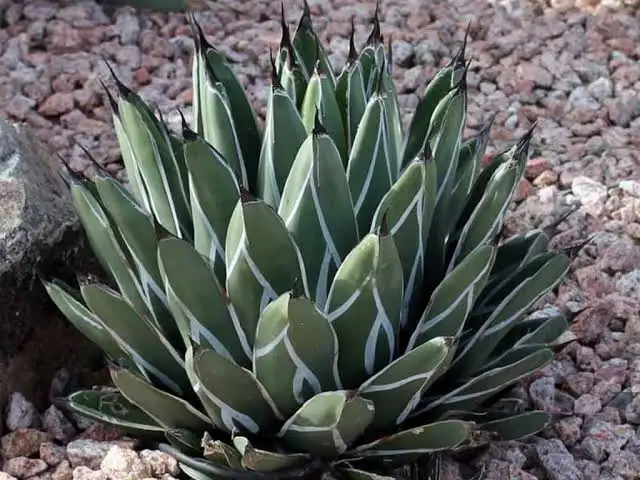
Agave nickelsiae, previously named Agave ferdinandi-regis, is type of agave that forms a striking compact rosette of stout, smooth and spineless, dark olive green leaves. Each leaf is beautifully adorned with ornamental white bud prints. Lacking teeth along the edges, they instead exhibit narrow white margins and are tipped by a contrasting black terminal spine.
Mature plants (over 15 years) flower only once. They are topped with a magnificent flowering spike that can reach 20 ft. (6 m), and bears dense clusters of yellow flowers flushed with purplish-red. Very slow-growing, this distinctive Agave is terrific for sunny borders or containers.
Also Read: Different Types of Kalanchoe Plants
Whale’s Tongue Agave
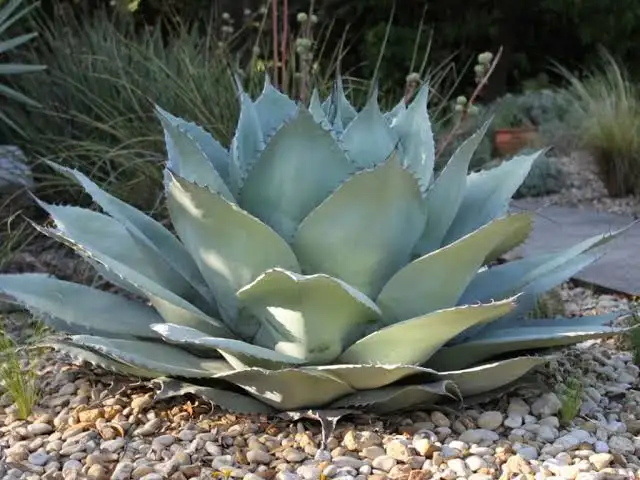
Surprisingly cold hardy, Agave ovatifolia ‘Frosty Blue’ (Whale’s Tongue Agave) is a type of agave forming a solitary rounded rosette of thick, broad, distinctively cupped, gray to powdery-blue leaves. Adding interesting texture and interest year-round, the leaves are lined with small teeth along their margins and tipped with a dark gray terminal spine.
Mature plants (over 10 years) flower only once. They are topped with a magnificent flowering spike that can reach 14 ft. (4m), and bears dense clusters of yellow-green flowers. This particular plant was selected by Sean Hogan of Cistus Nursery who notes that ” the plant has an almost turquoise hue and some nice powdery overlay (oh, and a smoky after finish!). It has been noted that this species has stayed smaller in hot dry locations where water has been withheld but responds well to irrigation and grows much larger.
Cabbage Head Agave
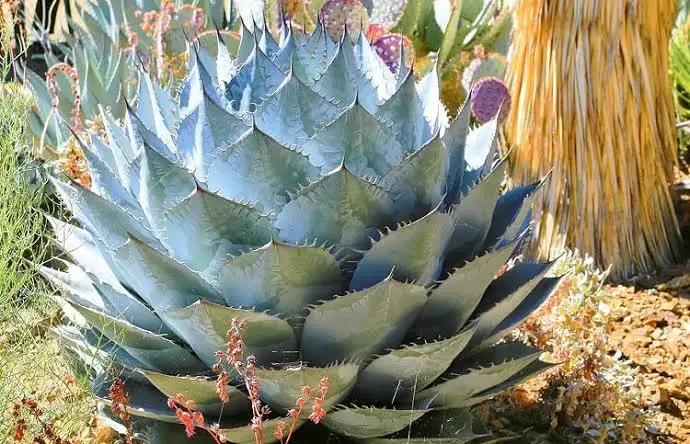
Agave parrasana (Cabbage Head Agave) is a compact evergreen, perennial succulent forming pretty rosettes of broad, closely packed and overlapping, pale blue-gray leaves, armed with gnarled teeth along the edges. The thick, rigid leaves are often irregularly dusted with a silvery blue coating, that shows impressive bud imprints and creates a lovely mottled appearance. They are adorned with a stout, dark chestnut brown, terminal spine that turns gray over time.
Agave parrasana is usually a non-offsetting species and its rosettes are solitary, but some plants may produce suckers and form small clumps. While infrequent, mature plants (over 10 years) flower only once. They are topped with a magnificent flowering spike that can reach 12 ft. (4m), and bears dense flower clusters, red in bud, opening yellow to create a riot of color.
Artichoke Agave
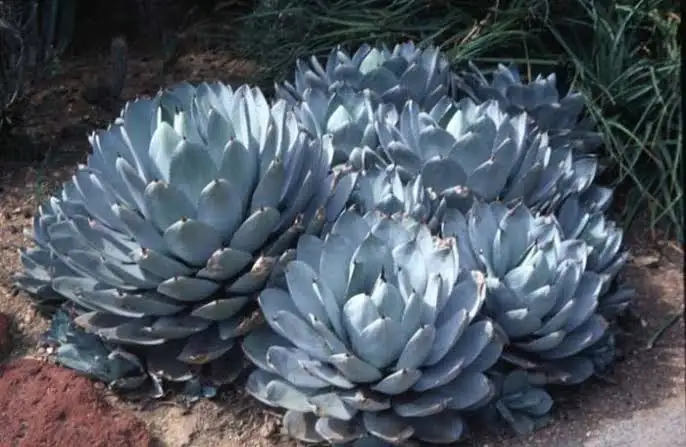
Fairly compact and cold tolerant, Agave parryi var. truncata (Artichoke Agave) is a type of agave forming tight rosettes of broad, short, thick, silvery-blue leaves with conspicuous reddish-brown teeth and terminal spines. While infrequent, mature plants (over 10 years) flower only once.
They are topped with a magnificent flowering spike that can reach 15 ft. (5m), and bears dense clusters of yellow flowers, tinged orange in bud. The flowering rosette dies after flowering, but new rosettes formed by offsets will root at the base of the mother rosette to form colonies. Amazing when massed in a sunny garden or in large containers.
Coastal Agave

Agave shawii (Coastal Agave) is an evergreen, perennial succulent forming a rosette of fleshy, sword-shaped, green leaves which radiate gracefully from the center of the plant, giving it a neat and rounded shape. They are lined with gray spines which exhibit coral, gold, pink or red shades when backlit, adding intriguing beauty.
While infrequent, mature plants (over 10 years) flower only once. They are topped with a magnificent flowering spike that can reach 12 ft. (4m), and bears clusters of yellow flowers. The flowering rosette dies after flowering, but new rosettes formed by offsets will root to form colonies.
Agave striata
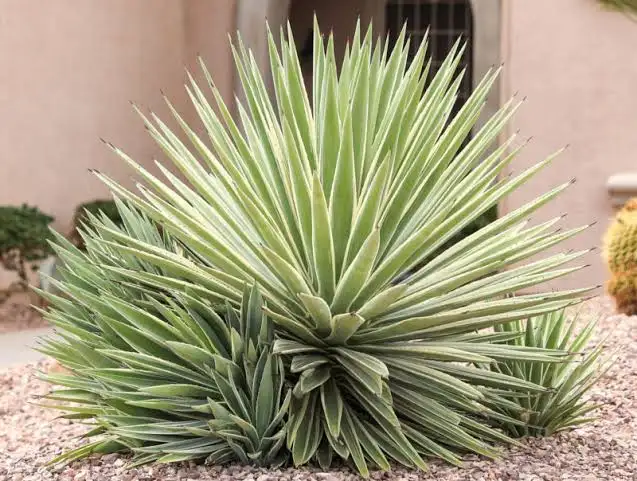
Agave striata (Narrow Leaf Century Plant) is a type of agave popularly known for forming interesting rosettes of thin, gray-green leaves with a sharp, dark brown terminal spine. Radiating from the center, the leaves can be stiff or upward curving, and may add lovely purple tones in drought or cold. They are topped with unbranched flowering stalks which emerges straight up from the heart and can reach 10 ft. (3 m). It bears pale yellow flowers that attract hummingbirds.
This Agave produces abundant offshoots or pups after flowering to form small colonies. In the wild, numerous suckers result in thick clusters of plants growing to form impenetrable thickets. This specimen agave also looks nice when mixed with ornamental grasses and perennials.
Utah Agave

Agave utahensis (Utah Agave) is a small agave forming basal rosette which grows to around 30cms in height and width. The leaves are linear to lance-shaped and grey-green in colour, with long white spines protruding from the tips. The flowers are produced in the summer with yellow blooms in upright panicles or racemes on a towering flower stalk up to 4 metres high.
Agave utahensis was used in the ares of its origin for food purposes and even as a textile fiber to create warm blankets. Adapted to growing in completely desert territories, this plant is extremely resistant to both extreme heat and intense cold, therefore it is perfect for giving a touch of style and elegance even to the environments of novice growers.
Octopus Agave

Agave vilmoriniana (Octopus Agave) is a very unusual looking agave variety that forms a solitary rosette of long, slender, gray-green leaves that arch and undulate, resembling the tentacles of an octopus. The toothless edges of the leaves curl inward, particularly around the tips. Spectacular golden-yellow flowers atop a 10-20 ft. spike appear on mature plants (after 10 years).
This plant is monocarpic and dies after flowering. While it does not offset and form pups, it produces abundant plantlets along the bloom spike that you may want to replant in order to ensure a continuing presence of this beauty in the garden. This plant makes a dramatic focal point in sunny borders or decorative containers.
Agave weberi ‘Arizona Star’

Agave weberi ‘Arizona Star’ (Variegated Weber Agave) is a Medium sized rosette-forming agave to 4 feet tall by 6 feet wide with fleshy, spine-tipped blue-green leaves that have a wide marginal pale yellow stripe along the nearly spineless margins.
At maturity, this plant creates a 12-15 ft high, branched, flower, flower stalk with clusters of yellow blossoms. It also produces many offsets that help to further propagate the plant. Use it as a focal or accent plant in large, open spaces or tropical settings around water features and ponds. This specimen agave also looks nice when mixed with ornamental grasses and perennials.
Agave univittata ‘Quadricolor’

Agave univittata ‘Quadricolor’ is a highly ornamental evergreen succulent forming colorful rosettes of toothed, strikingly-striped leaves about 6-12 in. long (15-30 cm). Dark green in their center, the leaves are adorned with a pale green mid-stripe and golden-yellow edges, which are lined with a row of dark reddish teeth.
When exposed to bright sun, they redden – hence, the name ‘Quadricolor’. Under cold or drought, the leaves add on lovely shades of pink to red, further enhancing the colorful display. This Agave looks terrific when planted in multiples. As an added bonus, it produces many offsets that can be re-planted elsewhere.
Agave Scabra

A medium sized agave growing to about 4 feet tall with thick blue-gray 3 foot long leaves that are 4 to 6 inches wide at the widest point towards the middle and deeply guttered lengthwise with a tapering tip ending in a long dark brown spine and with large teeth along the margins.
The flowers are bright yellow in peduncles of a 15 to 20 foot tall spike. The flowers attract nectar feeding birds but as with other agave it doesn’t bloom often (in this case after about 15 years) and after it does, the flowering rosettes dies but is replaced by new plants (suckers) emerging at the base.
Cow Horn Agave
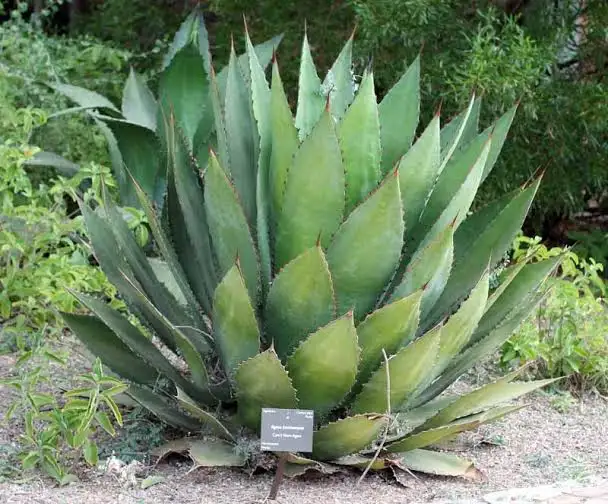
Agave bovicornuta is a perennial medium-sized, non-suckering plant with a short stem, forming a solitary light green, open, rosette that usually grows wider than it gets tall, maxing out at about up to 80-100 cm in height and 1.5-2 m wide, but frequently smaller.
It is quickly recognized by its large size and bright green, decorative, broadly lanceolate or spatulate leaves, that are 45-60 cm long and 10-15 cm wide. The most sought after forms have very broadly spoon-shaped leaves with deliciously wicked teeth. Yellowish-green flowers are borne on a stalk up to 5-6 m tall after the plant overcome the age of 10-12 years.
Guiengola Agave

Agave guiengola (Guiengola Agave) is a large variety of agave that forms open rosettes to 4-5 feet tall by 4 to 6 feet wide. The few massively thick white-green glaucous leaves are very broad at the base and taper to a brown terminal spine. Along the edge of the 24 to 36 inch long leaves there are many tiny dark-colored blunt teeth. When mature this plant produces a 8 to 10 foot tall unbranched spike with pale yellow flowers.